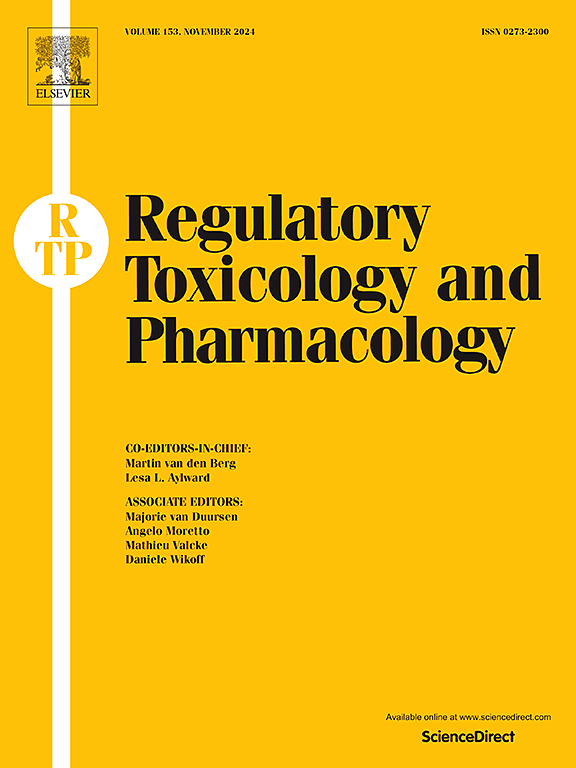In vivo screening evaluation of 12 chemicals as candidate endocrine disruptors using ovariectomized mouse uterotrophic bioassay
IF 3.5
4区 医学
Q1 MEDICINE, LEGAL
引用次数: 0
Abstract
The rodent uterotrophic bioassay is helpful to easily predict and evaluate the estrogenic properties of chemicals by measuring changes in uterine weight as a screening test. We used this assay in ovariectomized (OVX) mice to screen 12 chemicals suspected to be estrogenic or antiestrogenic properties by in vitro assays in the screening project of the Ministry of Health, Labour and Welfare, Japan. We administered each chemical to 8-week-old OVX mice either orally (po) or by subcutaneous (sc) injection at 24-hr intervals for 7 consecutive days. Ethinyl estradiol was used as reference control. Our study revealed for the first time that po or sc administration of 1,1,1-tris(4-hydroxyphenyl)ethane exerted estrogenic effects at nontoxic dose, with a LOEL of 300 mg/kg for both routes. In contrast, sc administration, but not po administration, of dibenzoylmethane, tricresyl phosphate, and triphenylsilanol exerted antiestrogenic effects, with a LOEL of 30 mg/kg for each chemical. Furthermore, po and sc administration of 4,4′-butylidenebis[6-tert-butyl-3-methylphenol] exerted antiestrogenic effects, with a LOEL of 100 mg/kg for both routes. Taken together, we revealed that only 5 of the 12 substances of concern in vitro were active in vivo, which could be helpful for the effective detection of estrogenic and antiestrogenic activities. The five positive substances were considered to require further consideration in the prioritization list of higher-order toxicity testing for their endocrine disrupting effects.

利用去卵巢小鼠子宫营养生物测定法对12种候选内分泌干扰物进行体内筛选评价。
啮齿类动物子宫营养生物测定是一种通过测量子宫重量变化来预测和评价化学物质雌激素特性的筛选试验。在日本厚生劳动省的筛选项目中,我们在卵巢切除(OVX)小鼠中使用该方法筛选了12种被怀疑具有雌激素或抗雌激素特性的化学物质。我们给8周大的OVX小鼠口服(po)或皮下注射(sc),每隔24小时,连续7天。以雌二醇乙酯为对照。我们的研究首次揭示了po或sc给药1,1,1-三(4-羟基苯基)乙烷在无毒剂量下发挥雌激素作用,两种途径的LOEL均为300 mg/kg。相比之下,二苯甲酰甲烷、磷酸三甲酯和三苯基硅醇的sc给药(而非po给药)具有抗雌激素作用,每种化学物质的LOEL均为30 mg/kg。此外,po和sc给药4,4'-butylidenebis[6-叔丁基-3-甲基苯酚]具有抗雌激素作用,两种途径的LOEL均为100 mg/kg。综上所述,我们发现12种体外关注物质中只有5种在体内有活性,这有助于有效检测雌激素和抗雌激素活性。这五种阳性物质被认为需要在高阶毒性测试的优先清单中进一步考虑其内分泌干扰作用。
本文章由计算机程序翻译,如有差异,请以英文原文为准。
求助全文
约1分钟内获得全文
求助全文
来源期刊
CiteScore
6.70
自引率
8.80%
发文量
147
审稿时长
58 days
期刊介绍:
Regulatory Toxicology and Pharmacology publishes peer reviewed articles that involve the generation, evaluation, and interpretation of experimental animal and human data that are of direct importance and relevance for regulatory authorities with respect to toxicological and pharmacological regulations in society. All peer-reviewed articles that are published should be devoted to improve the protection of human health and environment. Reviews and discussions are welcomed that address legal and/or regulatory decisions with respect to risk assessment and management of toxicological and pharmacological compounds on a scientific basis. It addresses an international readership of scientists, risk assessors and managers, and other professionals active in the field of human and environmental health.
Types of peer-reviewed articles published:
-Original research articles of relevance for regulatory aspects covering aspects including, but not limited to:
1.Factors influencing human sensitivity
2.Exposure science related to risk assessment
3.Alternative toxicological test methods
4.Frameworks for evaluation and integration of data in regulatory evaluations
5.Harmonization across regulatory agencies
6.Read-across methods and evaluations
-Contemporary Reviews on policy related Research issues
-Letters to the Editor
-Guest Editorials (by Invitation)

 求助内容:
求助内容: 应助结果提醒方式:
应助结果提醒方式:


